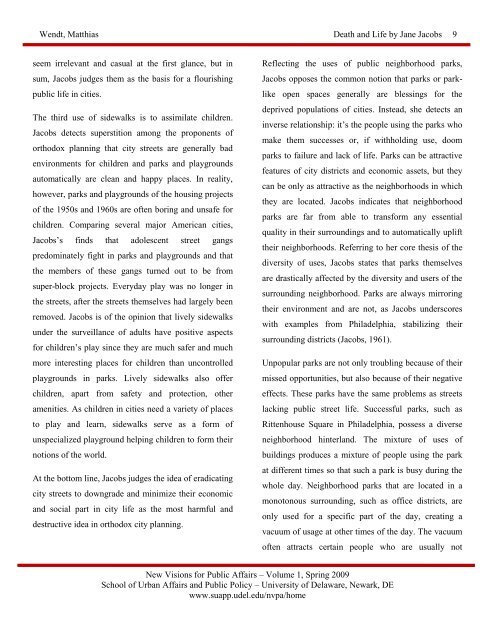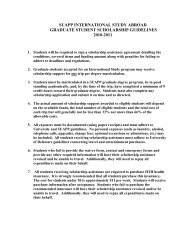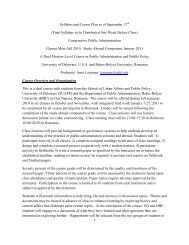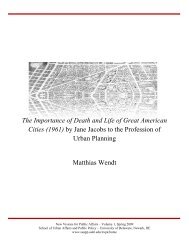New Visions for Public Affairs Volume 1 - School of Public Policy ...
New Visions for Public Affairs Volume 1 - School of Public Policy ...
New Visions for Public Affairs Volume 1 - School of Public Policy ...
You also want an ePaper? Increase the reach of your titles
YUMPU automatically turns print PDFs into web optimized ePapers that Google loves.
Wendt, Matthias Death and Life by Jane Jacobs 9<br />
seem irrelevant and casual at the first glance, but in<br />
sum, Jacobs judges them as the basis <strong>for</strong> a flourishing<br />
public life in cities.<br />
The third use <strong>of</strong> sidewalks is to assimilate children.<br />
Jacobs detects superstition among the proponents <strong>of</strong><br />
orthodox planning that city streets are generally bad<br />
environments <strong>for</strong> children and parks and playgrounds<br />
automatically are clean and happy places. In reality,<br />
however, parks and playgrounds <strong>of</strong> the housing projects<br />
<strong>of</strong> the 1950s and 1960s are <strong>of</strong>ten boring and unsafe <strong>for</strong><br />
children. Comparing several major American cities,<br />
Jacobs’s finds that adolescent street gangs<br />
predominately fight in parks and playgrounds and that<br />
the members <strong>of</strong> these gangs turned out to be from<br />
super-block projects. Everyday play was no longer in<br />
the streets, after the streets themselves had largely been<br />
removed. Jacobs is <strong>of</strong> the opinion that lively sidewalks<br />
under the surveillance <strong>of</strong> adults have positive aspects<br />
<strong>for</strong> children’s play since they are much safer and much<br />
more interesting places <strong>for</strong> children than uncontrolled<br />
playgrounds in parks. Lively sidewalks also <strong>of</strong>fer<br />
children, apart from safety and protection, other<br />
amenities. As children in cities need a variety <strong>of</strong> places<br />
to play and learn, sidewalks serve as a <strong>for</strong>m <strong>of</strong><br />
unspecialized playground helping children to <strong>for</strong>m their<br />
notions <strong>of</strong> the world.<br />
At the bottom line, Jacobs judges the idea <strong>of</strong> eradicating<br />
city streets to downgrade and minimize their economic<br />
and social part in city life as the most harmful and<br />
destructive idea in orthodox city planning.<br />
Reflecting the uses <strong>of</strong> public neighborhood parks,<br />
Jacobs opposes the common notion that parks or parklike<br />
open spaces generally are blessings <strong>for</strong> the<br />
deprived populations <strong>of</strong> cities. Instead, she detects an<br />
inverse relationship: it’s the people using the parks who<br />
make them successes or, if withholding use, doom<br />
parks to failure and lack <strong>of</strong> life. Parks can be attractive<br />
features <strong>of</strong> city districts and economic assets, but they<br />
can be only as attractive as the neighborhoods in which<br />
they are located. Jacobs indicates that neighborhood<br />
parks are far from able to trans<strong>for</strong>m any essential<br />
quality in their surroundings and to automatically uplift<br />
their neighborhoods. Referring to her core thesis <strong>of</strong> the<br />
diversity <strong>of</strong> uses, Jacobs states that parks themselves<br />
are drastically affected by the diversity and users <strong>of</strong> the<br />
surrounding neighborhood. Parks are always mirroring<br />
their environment and are not, as Jacobs underscores<br />
with examples from Philadelphia, stabilizing their<br />
surrounding districts (Jacobs, 1961).<br />
Unpopular parks are not only troubling because <strong>of</strong> their<br />
missed opportunities, but also because <strong>of</strong> their negative<br />
effects. These parks have the same problems as streets<br />
lacking public street life. Successful parks, such as<br />
Rittenhouse Square in Philadelphia, possess a diverse<br />
neighborhood hinterland. The mixture <strong>of</strong> uses <strong>of</strong><br />
buildings produces a mixture <strong>of</strong> people using the park<br />
at different times so that such a park is busy during the<br />
whole day. Neighborhood parks that are located in a<br />
monotonous surrounding, such as <strong>of</strong>fice districts, are<br />
only used <strong>for</strong> a specific part <strong>of</strong> the day, creating a<br />
vacuum <strong>of</strong> usage at other times <strong>of</strong> the day. The vacuum<br />
<strong>of</strong>ten attracts certain people who are usually not<br />
<strong>New</strong> <strong>Visions</strong> <strong>for</strong> <strong>Public</strong> <strong>Affairs</strong> – <strong>Volume</strong> 1, Spring 2009<br />
<strong>School</strong> <strong>of</strong> Urban <strong>Affairs</strong> and <strong>Public</strong> <strong>Policy</strong> – University <strong>of</strong> Delaware, <strong>New</strong>ark, DE<br />
www.suapp.udel.edu/nvpa/home







